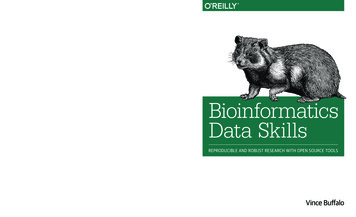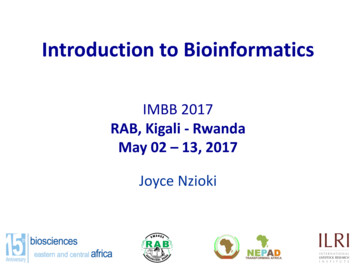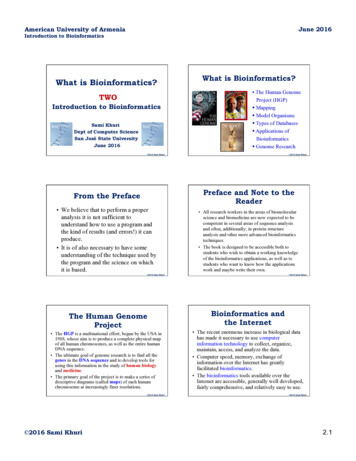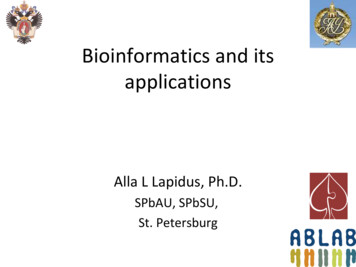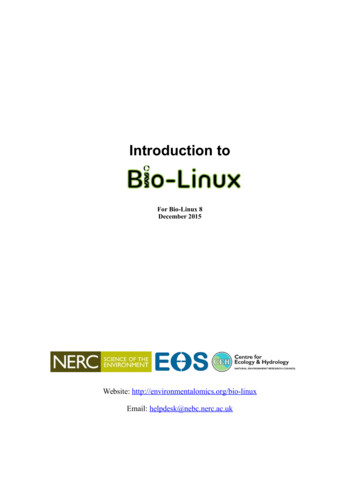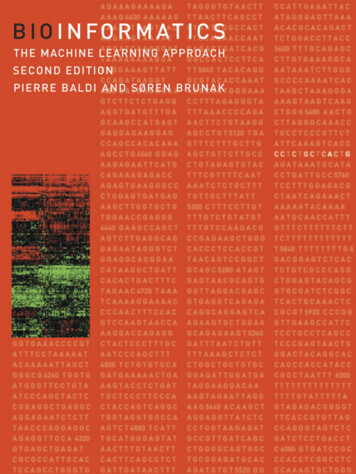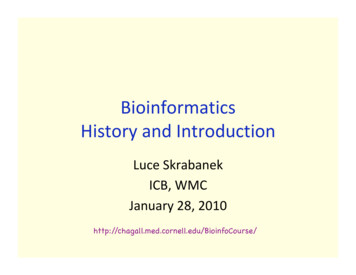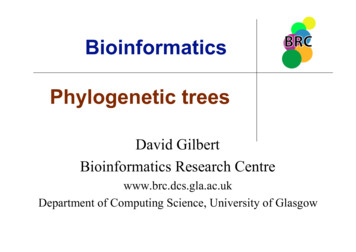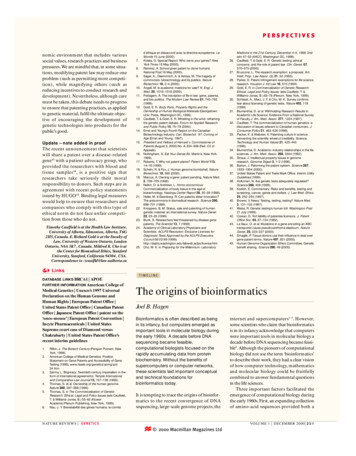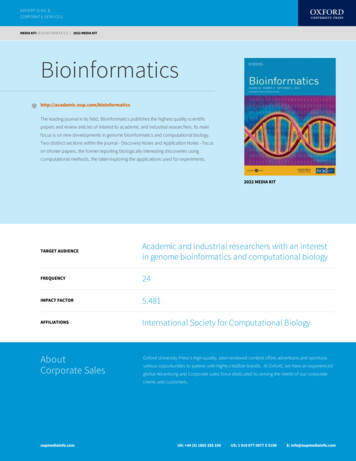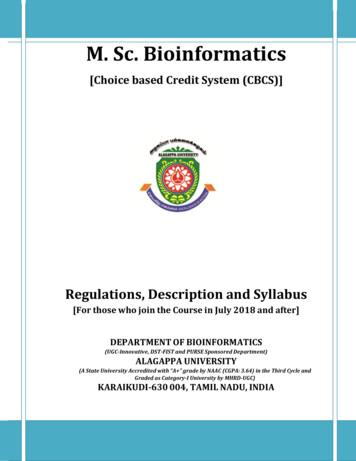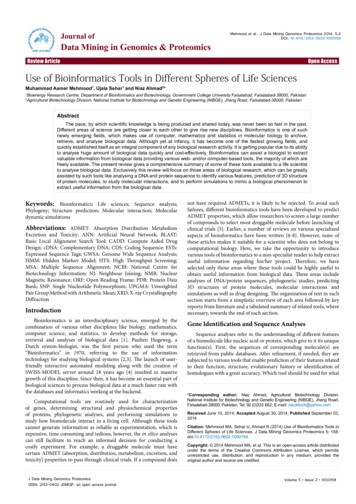
Transcription
Journal of&csProteomicsal of DataurnJong in GenominiiMData Mining in Genomics & ProteomicsISSN: 2153-0602Mehmood et al., J Data Mining Genomics Proteomics 2014, 5:2DOI: 10.4172/2153-0602.1000158Review ArticleOpen AccessUse of Bioinformatics Tools in Different Spheres of Life SciencesMuhammad Aamer Mehmood1, Ujala Sehar1 and Niaz Ahmad2*12Bioenergy Research Centre, Department of Bioinformatics and Biotechnology, Government College University Faisalabad, Faisalabad-38000, PakistanAgricultural Biotechnology Division, National Institute for Biotechnology and Genetic Engineering (NIBGE), Jhang Road, Faisalabad-38000, PakistanAbstractThe pace, by which scientific knowledge is being produced and shared today, was never been so fast in the past.Different areas of science are getting closer to each other to give rise new disciplines. Bioinformatics is one of suchnewly emerging fields, which makes use of computer, mathematics and statistics in molecular biology to archive,retrieve, and analyse biological data. Although yet at infancy, it has become one of the fastest growing fields, andquickly established itself as an integral component of any biological research activity. It is getting popular due to its abilityto analyse huge amount of biological data quickly and cost-effectively. Bioinformatics can assist a biologist to extractvaluable information from biological data providing various web- and/or computer-based tools, the majority of which arefreely available. The present review gives a comprehensive summary of some of these tools available to a life scientistto analyse biological data. Exclusively this review will focus on those areas of biological research, which can be greatlyassisted by such tools like analysing a DNA and protein sequence to identify various features, prediction of 3D structureof protein molecules, to study molecular interactions, and to perform simulations to mimic a biological phenomenon toextract useful information from the biological data.Keywords: Bioinformatics; Life sciences; Sequence analysis;Phylogeny; Structure prediction; Molecular interaction; Moleculardynamic simulationsAbbreviations: ADMET: Absorption Distribution MetabolismExcretion and Toxicity; ANN: Artificial Neural Network; BLAST:Basic Local Alignment Search Tool; CADD: Compute Aided DrugDesign; cDNA: Complementary DNA; CDS: Coding Sequence; ESTs:Expressed Sequence Tags; GWSA: Genome Wide Sequence Analysis;HMM: Hidden Markov Model; HTS: High Throughput Screening;MSA: Multiple Sequence Alignment; NCBI: National Centre forBiotechnology Information; NJ: Neighbour Joining; NMR: NuclearMagnetic Resonance; ORF: Open Reading Frame; PDB: Protein DataBank; SNP: Single Nucleotide Polymorphism; UPGMA: UnweightedPair Group Method with Arithmetic Mean; XRD: X-ray cs is an interdisciplinary science, emerged by thecombination of various other disciplines like biology, mathematics,computer science, and statistics, to develop methods for storage,retrieval and analyses of biological data [1]. Paulien Hogeweg, aDutch system-biologist, was the first person who used the term“Bioinformatics” in 1970, referring to the use of informationtechnology for studying biological systems [2,3]. The launch of userfriendly interactive automated modeling along with the creation ofSWISS-MODEL server around 18 years ago [4] resulted in massivegrowth of this discipline. Since then, it has become an essential part ofbiological sciences to process biological data at a much faster rate withthe databases and informatics working at the backend.Computational tools are routinely used for characterizationof genes, determining structural and physiochemical propertiesof proteins, phylogenetic analyses, and performing simulations tostudy how biomolecule interact in a living cell. Although these toolscannot generate information as reliable as experimentation, which isexpensive, time consuming and tedious, however, the in silico analysescan still facilitate to reach an informed decision for conducting acostly experiment. For example, a druggable molecule must havecertain ADMET (absorption, distribution, metabolism, excretion, andtoxicity) properties to pass through clinical trials. If a compound doesJ Data Mining Genomics ProteomicsISSN: 2153-0602 JDMGP, an open access journalnot have required ADMETs, it is likely to be rejected. To avoid suchfailures, different bioinformatics tools have been developed to predictADMET properties, which allow researchers to screen a large numberof compounds to select most druggable molecule before launching ofclinical trials [5]. Earlier, a number of reviews on various specializedaspects of bioinformatics have been written [6-8]. However, none ofthese articles makes it suitable for a scientist who does not belong tocomputational biology. Here, we take the opportunity to introducevarious tools of bioinformatics to a non-specialist reader to help extractuseful information regarding his/her project. Therefore, we haveselected only those areas where these tools could be highly useful toobtain useful information from biological data. These areas includeanalyses of DNA/protein sequences, phylogenetic studies, predicting3D structures of protein molecules, molecular interactions andsimulations as well as drug designing. The organization of text in eachsection starts from a simplistic overview of each area followed by keyreports from literature and a tabulated summary of related tools, wherenecessary, towards the end of each section.Gene Identification and Sequence AnalysesSequence analyses refer to the understanding of different featuresof a biomolecule like nucleic acid or protein, which give to it its uniquefunction(s). First, the sequences of corresponding molecule(s) areretrieved from public databases. After refinement, if needed, they aresubjected to various tools that enable prediction of their features relatedto their function, structure, evolutionary history or identification ofhomologues with a great accuracy. Which tool should be used for what*Corresponding author: Niaz Ahmad, Agricultural Biotechnology Division,National Institute for Biotechnology and Genetic Engineering (NIBGE), Jhang Road,Faisalabad-38000, Pakistan, Tel: 92 (0)333 662; E-mail: niazbloch@yahoo.comReceived June 10, 2014; Accepted August 30, 2014; Published September 03,2014Citation: Mehmood MA, Sehar U, Ahmad N (2014) Use of Bioinformatics Tools inDifferent Spheres of Life Sciences. J Data Mining Genomics Proteomics 5: 158.doi:10.4172/2153-0602.1000158Copyright: 2014 Mehmood MA, et al. This is an open-access article distributedunder the terms of the Creative Commons Attribution License, which permitsunrestricted use, distribution, and reproduction in any medium, provided theoriginal author and source are credited.Volume 5 Issue 2 1000158
Citation: Mehmood MA, Sehar U, Ahmad N (2014) Use of Bioinformatics Tools in Different Spheres of Life Sciences. J Data Mining GenomicsProteomics 5: 158. doi:10.4172/2153-0602.1000158Page 2 of 13ToolDescriptionReferencesBLASTIt is a search tool, used for DNA or protein sequence search based on identity.[109]HMMERHomologous protein sequences may be searched from the respective databases using this tool.[110]Clustal OmegaMultiple sequence alignments may be performed using this program.[111]SequeromeUsed for sequence profiling.[112]ProtParamUsed to predict the physico-chemical properties of proteins.[113]JIGSAWTo find genes, and to predict the splicing sites in the selected DNA sequences.[114]novoSNPUsed to find the single nucleotide variation in the DNA sequence.[115]ORF FinderThe putative genes may be subjected to this tool to find Open Reading Frame (ORF).http://www.ncbi.nlm. nih.gov/projects/gorf/PPPProkaryotic promoter prediction tool used to predict the promoter sequences present up-stream thegenehttp://bioinformatics. biol.rug.nl/websoftware/ppp/ppp start.phpVirtual FoorprintWhole prokaryotic genome (with one regular pattern) may be analysed using this program alongwith promoter regions with several regulator patterns.[116]WebGeSTerThis is a database containing sequences of transcription terminator sequences and is used topredict the termination sites of the genes during transcription.[117]GenscanUsed to predict the exon-intron sites in genomic sequences.[118]Softberry ToolsSeveral tools are specialized in annotation of animal, plant, and bacterial genomes along with thestructure and function prediction of RNA and proteins.www.softberry.comTable 1: Selected tools for primary sequence analyses.depends on the very nature of analysis to be carried out . For example,data retrieval tools such as Entrez of PubMed [9] allows one to searchand retrieve data from a wide range of data domains. Similarly, patterndiscovery tools such as Expression Profiler [10], Gene Quiz [11] allowresearchers to search out different patterns in the given data. Anotherset of tools is dedicated to carry out sequence comparison. These toolssuch as BLAST (Basic Local Alignment Search Tool) [12], ClustalW[13] enable one to compare gene or protein sequences to study theirevolutionary history or origin. The data visualization tools such asJalview [14], GeneView [15], TreeView [16], Genes-Graphs [17] allowresearchers to view data in graphic representation. These tools useadvanced mathematical modelling and statistical inferences such asdynamic programming, Hidden Markov Model (HMM), Regressionanalysis, Artificial Neural Network (ANN), Clustering and SequenceMining to analyse the given sequence.These analyses are popular due to their huge applications inbiological sciences, the simplicity, and the capacity to generate a wealthof knowledge about the gene/protein in question. These types of analysesare particularly useful for identification of promoter, terminator, or untranslated regions involved in the expression regulations, recognitionof a transit peptide, introns, exons or an open reading frame (ORF),and identification of certain variable regions to be used as signaturesfor diagnostic purposes. Therefore, sequence analyses are one of thefrequently performed analyses of bioinformatics. For example, Stoilovet al. [18] used sequence analysis coupled with homology modellingto investigate the genetic basis of primary congenital glaucoma(PCG) [18]. The authors were able to underpin mutations that impairthe proper folding and haeme-binding ability of CYP1B1 peptides.Similarly, a genome-wide sequence analysis (GWSA) of Mycobacteriumtuberculosis H37Rv revealed that majority of the bacterium’s proteinswere the result of repetitive gene duplication or exon–shuffling events[19]. In a recent study, the gene cbp50 from Bacillus thuringiensisserovar konkukian was predicted to encode protein that featuresmultiple chitin-binding domains [20,21]. Similarly, Rho-independenttranscription terminators form a collection of 343 prokaryotic genomeswere predicted quite accurately ( 6% false positive prediction) usingvarious computational tools [22].Mostly predictions rely on complementary DNA (cDNA)and Expressed Sequence Tags (ESTs). However, the cDNA/ESTsinformation is often scarce and incomplete, and therefore makes thetask of finding new genes hugely difficult. Computational scientistsJ Data Mining Genomics ProteomicsISSN: 2153-0602 JDMGP, an open access journalhave developed another technique referred as an ab initio geneidentification. The potential of this technique was demonstrated ina study, which was able to predict 88% of already verified exons and90% of the coding nucleotides from Drosophila melanogaster withvery low rate of false-positive identification [23]. Keeping in viewthe accuracy ( 90%) delivered by this approach, it could be a reliabletool for annotating lengthy genomic sequences and prediction of newgenes. Recently, Lencz et al. [24] were able to identify an inter-genicSingle Nucleotide Polymorphic (SNP; rs11098403) at chromosome4q26 linked with schizophrenia and bipolar disorder by performing agenome-wide association study (GWAS) coupled with cDNA and RNASeq on a set of 23,191 individuals (5,415 schizophrenic, 4,785 bipolarand 12,991 controls) [24]. The rs11098403 was found to be linkedwith the expression of neighbouring enzyme, NDST3, involved in themetabolism of heparan sulphate (HS) in the brain tissues. Similarly,Peng and co-workers (2013) predicted the function of 31,987 genesfrom the draft genome of a forest species Phyllostachys heterocyclausing gene prediction modelling approaches based on FgeneSH [25]. Please refer to Table 1 for a list of tools used in primary sequenceanalyses.Phylogenetic AnalysesPhylogenetic analyses are procedures used to reconstruct theevolutionary relationship among a group of related molecules ororganisms, to predict certain features of a molecule with unknownfunctions, to track gene flow, and to determine genetic relatedness[26]. This all could be represented on a genealogic tree or tree of life.The underlying principle of phylogeny is to group living organismsaccording to the degree of similarity: greater the similarity, closer theorganisms would appear on a tree. A phylogenetic comparative analysisis widely used to control for the lack of statistical independence amongspecies [27].The methods to construct a phylogenetic tree are divided into threemajor groups: distance methods, parsimony methods, and likelihoodmethods. None of the methods is perfect; each one has its ownparticular strengths and weaknesses. For example, the distance-basedtrees are easy to set up but not that accurate. The maximum parsimonyand maximum likelihood methods are (in theory) the most accurate,but they take more time to run [28]. The distance-matrix methods suchas Neighbour Joining (NJ) or Unweighted Pair Group Method withArithmetic mean (UPGMA) are the simplest. The experts believe thatVolume 5 Issue 2 1000158
Citation: Mehmood MA, Sehar U, Ahmad N (2014) Use of Bioinformatics Tools in Different Spheres of Life Sciences. J Data Mining GenomicsProteomics 5: 158. doi:10.4172/2153-0602.1000158Page 3 of 13ToolDescriptionMEGA (Molecular Evolutionary Genetics Analysis)Builds phylogenetic tress to study the evolutionary closeness.Reference[119]MOLPHYIt is molecular phylogenetic analysis tool based on maximum likelihood method.[120][121]PAMLA phylogenetic analysis tool based on maximum likelihood.PHYLIPA package for phylogenetic studies.[122]JStreeAn open-source library for viewing and editing phylogenetic trees for presentation improvement.[123]TreeViewSoftware to view the phylogenetic trees, with the provision of changing view.[124]JalviewIt is an alignment editor and is used to refine the alignment[125]Table 2: Some popular tools used for phylogenetic analyses.the neighbour joining method provides a very good trade-off betweenthe available methods.Since discussing the details of each bit for performing MSA,building trees, and testing best fits is beyond the scope of this article,therefore, the reader is referred to the detailed protocol published by theMolecular Genetics Laboratory, Central University of Punjab [29] onthis issue. Table 2 lists some widely used tools in phylogenetic analyses.Phylogenetic tools are commonly used to test various evolutionaryhypotheses and have become indispensable for functional genomics,particularly when the functions of a gene are not known. For example,prior to the expression of an algal membrane protein, plastid terminaloxidase 1 (PTOX1), in tobacco chloroplasts, authors conducteda phylogenetic analysis to construct the evolutionary history anddetermine essential features of that particular polypeptide [30]. Thephylogenetic analysis revealed that the Chlamydomonas reinhardtiiPTOX1 (Cr-PTOX1) has typical signatures of higher plant PTOX suchas iron-binding sites, a conserved exon and various blocks of aminoacids to act as plastoquinol terminal oxidase [30]. Similarly, Chen etal. [31] used phylogenetic analysis to study the evolutionary historyof respiratory mechanisms in the deep-sea bacterium Shewanellapiezotolerans WP3 [31]. The phylogenetic analyses coupled with reversegenetic studies revealed that out of two nitrate reductases, NAP-α andNAP-β, the hallmark of the genus Shewanella, the NAP-β evolved longbefore NAP-α molecules.Sequence DatabasesBiological sequence database refers to a vast collection ofinformation about biological molecules such as nucleic acids, proteinsand polymers, each molecule to be identified by a unique key. Thestored information is not only important for future use but also servesas a tool for primary sequence analyses. With the advancement of highthroughput sequencing techniques, the sequencing has reached to awhole-genome scale, which is generating a massive amount of dataevery day. The submission and storage of this information to becomefreely available to the scientific community has led to the developmentof various databases worldwide. Each database has become anautonomous representation of a molecular unit of life. This sectiondeals with such databases, as an understanding of these databases willhelp to retrieve important information from these data collectionsrelevant to one’s project.Databases contain a variety of information; and therefore areclassified into Primary, Secondary, or Composite databases, dependingupon the information stored in them. For example, the data in a primarydatabase is obtained through experimentation such as yeast-two hybridassay, affinity chromatography, XRD or NMR approaches such as relatedto sequence or structure. SWISS-PROT [32], UniProt [33] and PIR [34],GenBank [35], EMBL [36], DDBJ [37] and the Protein Databank PDB[38] are examples of primary databases. A secondary database containsinformation that is derived from the analysis of data stored in primaryJ Data Mining Genomics ProteomicsISSN: 2153-0602 JDMGP, an open access journaldatabases like conserved sequences, active sites of a protein family orconserved secondary motifs of protein molecules [39,40]. Examples ofsecondary databases include SCOP [41], CATH [42], PROSITE [43]eMOTIF [44]. Consequently, the primary databases are of archivalnature while secondary databases are termed as curated databases.A composite database contains information derived from differentprimary sources. Examples of composite databases include NRDB (nonredundant database), which contains data obtained from GenBank(CDS translations), PDB, SWISS-PROT, PIR, and PRF. Similarly,the INSD (International Nucleotide Sequence Database) is anotherexample of composite database, which is collection of nucleic acidsequences from EMBL, GenBank, and DDBJ. The UniProt (universalprotein sequence database) [45] represents another example, which isalso a collation of sequences derived from various other databases PIRPSD, Swiss-Prot, and TrEMBL. Similarly, wwPDB (worldwide PDB) isa composite of 3D structures in the RCSB (Research Collaboratory forStructural Bioinformatics), PDB, MSD, and PDBj [46].Genome Sequence DatabasesThe GenBank, built by the NCBI [35], is a vast collection of genomesequences of over 250,000 species. The data from GenBank can beaccessed through the NCBI’s integrated retrieval system, Entrez, whilethe literature is accessible via PubMed [47]. Each sequence carriesinformation about the literature, bibliography, organism, and a setof various other features, which include coding regions, promoters,untranslated regions, terminators, exons, introns, repeat regions,and translations. The sequence information stored in GenBank isobtained through submission both by the individual laboratoriesas well as by large-scale genome sequencing projects. Similarly, theXenbase is an updated resource of genomic and biological data onthe frogs including Xenopus laevis and Xenopus tropicalis [48], whereXenopus spp. are considered as model providing new knowledge in thefield of developmental biology which may exploited to modelling andsimulation studies of the human diseases.The Saccharomyces Genome Database (SGD) containscomprehensive information of the yeast (Saccharomyces cerevisiae) andalso provides bioinformatics tools to explore and analyse the dataavailable in SGD. The SGD may be used to study functional relationshipsamong gene sequence and gene products in other fungi and eukaryotes(http://www.yeastgenome.org/). Similarly, another genome databasecalled “WormBase” is developed and maintained by internationalconsortium of computer scientists and molecular biologists to provideprecise, recent and reachable information related to the molecularbiology of C. elegans and other related nematodes (http://www.wormbase.org). The webpage for this database also host several toolsfor the precise analyses of the stored information. Another up-to-datedatabase is “FlyBase” dedicated to provide information on the genes andgenomes of Drosophila melanogaster along with the tools to search genesequences, alleles, genetic aberrations, different phenotypes, andimages of the Drosophila species [49]. Similarly, the wFleaBase (http://Volume 5 Issue 2 1000158
Citation: Mehmood MA, Sehar U, Ahmad N (2014) Use of Bioinformatics Tools in Different Spheres of Life Sciences. J Data Mining GenomicsProteomics 5: 158. doi:10.4172/2153-0602.1000158Page 4 of 13DatabaseDescriptionReferenceNucleotide DatabasesDNA Data Bank of JapanIt is the member of International Nucleotide Sequence Databases (INSD) and is one of the biggest resources fornucleotide sequences.[37]European NucleotideArchiveIt captures and presents information relating to experimental workflows that are based around nucleotide sequencing.[126]GenBankIt is the member of International Nucleotide Sequence Databases (INSD) and is a nucleotide sequence resource.[47]RfamA collection of RNA families, represented by multiple sequence alignments[54]Protein DatabasesUniprotOne of the largest collection of protein sequences.[45]Protein Data BankThis is another major resource of proteins containing information of experimentally-determined structures of nucleic acids,proteins, and other complex assemblies.[38]PrositeProvides information on protein families, conserved domains and actives sites of the proteins.[43]PfamCollection of protein families[39]SWISS PROTA section of the UniProt Knowledgebase containing the manually annotated protein sequences[32].InterProDescribes the protein families, conserved domains and actives sites[127]Proteomics IdentificationsDatabaseA public source, containing supporting evidence for functional characterization and post-translation modification ofproteins and peptides.[128]EnsemblIt is a database containing annotated genomes of eukaryotes including human, mouse and other vertebrates.[129]PIRAn integrated public resource to support genomic and proteomic research[34]Genome databasesMiscellaneous DatabasesMedherbResource database for medicinally important herbsReactomeA peer-reviewed resource of human biological processes[130][131]TextPressoThis database provides full text literature searches of model organism research, helps database curators to identify andextract biological entities which include new allele and gene names and human disease gene orthologshttp://www.textpresso.org/TAIRThe Arabidopsis Information Resource (TAIR) maintains a database of genetic and molecular data for the modelplant Arabidopsis thaliana. It provides information on gene structure, gene product, gene expression, DNA and seedstocks, genome maps, genetic and physical ase is an online bioinformatics database for Dictyostelium discoideum.[132]Signalling & Metabolic Pathway DatabasesKEGGKEGG is a suite of databases and associated software for understanding and simulating higher-order functionalbehaviours of the cell or the organism from its genome information.[133]CMAPComplement Map Database is a novel and easily accessible research tool to assist the complement community andscientists from related disciplines in exploring the complement network and discovering new connections.[134]SGMPThe Signaling Gateway Molecule Pages (SGMP) database provides highly structured data on proteins which exist indifferent functional states participating in signal transduction pathways.[135]The Pathway Interaction Database (PID) is a collection of curated and peer-reviewed pathways composed of humanmolecular signaling and regulatory events and key cellular processes. It serves as a research to study the cellularpathways with a special emphasis on cancer.[136]The Human Metabolome Database (HMDB) is the most comprehensive curated collection of human metabolite andhuman metabolism data in the world. It contains records for more than 2180 endogenous metabolites with informationgathered from thousands of books, journal articles and electronic databases along an extensive collection of experimentalmetabolite concentration data compiled from hundreds of mass spectra (MS) and Nuclear Magnetic resonance (NMR)from the analyses performed on urine, blood and cerebrospinal fluid samples. The HMDB is designed to addressthe broad needs of biochemists, clinical chemists, physicians, medical geneticists, nutritionists and members of themetabolomics community.[137]PIDHMDBTable 3: List of some popular databases.wfleabase.org/) provides information on genes and genomes for speciesof the genus Daphnia (water flea) where Daphnia is considered as amodel system to study and understand the complex interplay betweengenome structure, gene expression, individual fitness, and populationlevel responses to chemical contaminants and environmental change.Although, the wFleaBase contains data from all species of the genus yetthe primary species are D. pulex and D. magna. Please refer to Table 3for further information on genome databases.provides information of its entries, which has been generated bothexperimental as well computational studies. It also provides links toseveral other data sources such as GenBank, EMBL, DDBJ, PDB andvarious other secondary protein databases namely domains, posttranslational modifications, species-specific data collections. Theprotein information in SWISS-PROT mainly concentrates on modelorganisms and human. The TrEMBL by contrast provides informationon proteins from all organisms [32].Protein Sequence DatabasesSimilarly, the PIR is another comprehensive collection of proteinsequences. It provides user several attractive features for example tosearch for a protein molecule via an ‘interactive text search’ and toperform various web-based analyses such as sequence alignment,matching of peptide molecules and peptide mass calculations [51].The most significant protein sequence databases include SWISSPROT (Swiss Protein) Databank [50], TrEMBL (translation of DNAsequences in EMBL) [32], UniProt (Universal Protein Resource) [33],PIR (Protein Information Resource) [34] and wwPDB (worldwideProtein DataBank). The SWISS-PROT [32] represents one of thecomprehensive protein sequence databases. The SWISS-PROTJ Data Mining Genomics ProteomicsISSN: 2153-0602 JDMGP, an open access journalThe UniProt is one of the comprehensive collections of proteinsequence resources, which are open to free access. The UniProt databaseVolume 5 Issue 2 1000158
Citation: Mehmood MA, Sehar U, Ahmad N (2014) Use of Bioinformatics Tools in Different Spheres of Life Sciences. J Data Mining GenomicsProteomics 5: 158. doi:10.4172/2153-0602.1000158Page 5 of 13emerged by combining SWISS-PROT, PIR and TrEMBL collections.It provides all sorts of protein information ranging from sequence tofunction [52]The worldwide Protein Data Bank (wwPDB) has been exclusivelydesigned to archive each single 3D structure of protein molecules tobecome freely available to the scientific community. The databank nowcontains over 83,000 experimentally generated structures. The PDBalso constantly develops tools for the users to provide better access tothe data [53].Miscellaneous DatabasesThe Rfam database contains comprehensive information aboutRNA molecules and their various features like secondary structures andgene expression modulating elements. The Rfam databases are hostedby the Wellcome Trust Sanger Institute and it is similar to the Pfamdatabase for annotating protein families [54]. As there are numberof curated databases available, one of such databases is IntAct, whichcontains data on protein interactions. All data manually curated byMINT (Molecular INTeraction database) curators has been shiftedonto the IntAct database at EMBL-EBI and have been merged with theexisting IntAct data collections [55].MINT is another database that stores information about proteinprotein interactions derived from already published data in literature[56]. Curated databases for information on complex metabolicpathways have also been built. For example, the Reactome is one suchcurated database that represents a range of diverse human processesranging from metabolism to signal transduction. The Reactome isan open source platform, which is freely available to be used and redistributed [57].The Transporters Classification Database (TCDB) is a collectionof membrane transporters [58]. It uses an internationally approvedTransport Classification (TC) system for the classification of protein,which is similar to that of Enzyme Commission (EC). However, italso has some differences from EC system; it provides functional andphylogenetic information as well, for example. The information ofmore than 600 families of transporters is available in this database. ATC number to sequenced homologues of unknown function is assignedonly if it belongs to rare or under-represented family. Various subunitsare represented by ‘S’ followed by a number such as S1, S2, S3 and soon. Whereas the proteins which act as accessory transporters as wellas those whose characterization is not complete yet are represented bynumber 8 and 9, respectively [59]. Similarly, the Carbohydrate-Activeenzyme Database (CAZy) contains comprehensive information aboutcarbohy
Bioinformatics is an interdisciplinary science, emerged by the combination of various other disciplines like biology, mathematics, computer science, and statistics, to develop methods for storage, retrieva
